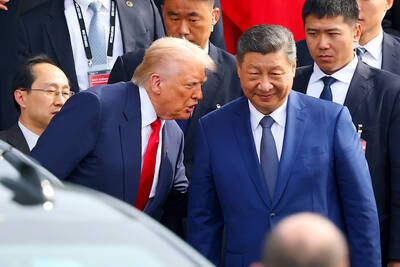Rescue efforts continued yesterday as search teams raced against time looking for thousands of villagers trapped by mudslides caused by Typhoon Morakot.
As of press time, more than 400 victims had been rescued by the military yesterday, but hundreds of villagers were still waiting for help and at least 400 people were unaccounted for.
Kaohsiung County — in particular Jiaxian (甲仙), Liukuei (六龜) and Namasia (那瑪夏) townships — had the highest number of casualties, with dozens of bodies found yesterday and hundreds still missing at press time.
One search and rescue team walked along destroyed and flooded roads to Liukuei Township for several hours to rescue villagers and found 26 bodies lying among fallen rocks.
“Give us body bags. We must get the bodies out first,” Su Ting-kuo (蘇定國), head of the team, said on the cable channel CTi-TV.
Lee Chi-hsiung (李智雄), director of political warfare at the Army Command Headquarters, said a unit of 13 soldiers, who began making their way to Jiaxian Township's Xiaolin Village (小林) on Monday, reached the site of Xiaolin Elementary School before noon yesterday.
Late last night, the Central News Agency reported that around 700 people had been located in the area and that they had been supplied with food and water and that evacuations would start today.
Military forces began rescue work at the crack of dawn yesterday, sending the first helicopter into Xiaolin Village at 6:12am and a second one at 9:13am, along with 73 more Army Special Forces, the Central Disaster Emergency Operation Center said.
Although media and some survivors said they feared hundreds had been buried under the mudslide in Xiaolin Village, the center said that the Army Special Forces had not found signs of people under the rubble by late last night.
Before noon, the army had evacuated scores of victims by helicopter from Xiaolin Village, Namasia's Minzu Village (民族), Jiaxian Township and Taoyuan Township's (桃源) Chinhe Village (勤和), the military said.
At 8:30pm, Taoyuan Township Meishan Village (梅山) suffered another devastating blow when the bank of a barrier lake collapsed, aggravating the flood in the area.
Kaohsiung County issued an emergency evacuation order for residents living near Laonong River (荖濃溪).
Drawing from reports of soldiers who had arrived at the affected villages, the center said the impact of the disaster on the five hardest hit villages had become clearer.
The center said that the military had air-dropped about 1.3 tonnes of supplies to the stranded victims in Xiaolin Village.
About 30 people were trapped atop Hsi-an Mountain (錫安), upstream from Xiaolin Village, the center said.
As the residents said their houses were still intact, they only asked that the military air-drop them food and supplies, the center said.
Further upstream in Namasia Township, about 100 people were trapped in Minzu Village, 100 in Namasia Village, 50 in Minchuan Village and 20 in Minsheng Village, the center said.
Although the military had been evacuating victims via helicopter from Xiaolin — which has the highest number of victims — since morning, clashes broke out between heartbroken and anxious survivors and the army, with several men trying to break through the military lines to get back onto the helicopters.
“I want to go back and find my family,” one man said.
The military later agreed to allow three men to return to their villages to rescue their families.
Four sisters from Liukuei Township's Chonghsing Village (中興) knelt in front of the news camera, pleading for rescue forces to go to their village as soon as possible.
“Our women, disabled people are trapped inside, nobody is there to save them ... We had no electricity, water, food and roads. Please save them, please go in and save them ... If somebody doesn't go in soon, you will have to prepare body bags for them,” one of them said.
After being relocated to Jiaxian's Cishan Junior High School, a Minzu Village survivor surnamed Lin (林) cried and pleaded for help to rescue 26 of her family members, who were still trapped in their village.
“My mother just suffered a stroke recently and has heart disease. I am so afraid that she won't make it,” Lin said.
“We also have children in the house, all of whom are under 15, and some are still in cribs,” she said.
Continuing heavy rain hampered rescue operations in mountainous villages, where hundreds of people were still thought to be stranded. The storm, which triggered the worst flooding in Taiwan in 50 years, dumped as much as 2m of rain before moving on to China.
The Central Weather Bureau (CWB) reported yesterday that Taiwan was still under the influence of air currents from the southwest and could still experience heavy rainfall after being battered by Morakot over the weekend.
Although Morakot left Taiwan on Sunday, it has joined with Typhoon Goni, which has lingered over China's Guangdong Province, to form a low pressure system whose rain clouds are being pushed toward Taiwan by a high pressure system from the north, the CWB said, adding that precipitation would be heavy in areas south of Miaoli County and warned that mountainous areas in central and southern Taiwan could be hit by more torrential rains.
The bureau said the rains should ease today.
Meanwhile, in Nantou County, one more body was found yesterday on the banks of the Choshui River along Highway 16 where five cars were suspected of falling into the river on Saturday after the road foundations were eroded.
Eight bodies had been found in the area, a Nantou official said.
Because Highway No. 9 leading to Taimali Township (太麻里) was still inaccessible, the Taitung County Government decided to drop food supplies to villagers. Local media reported that 200 people were trapped in Lidao Village (利稻) as Lidao Bridge had been destroyed by the flood.
As of press time, Morakot had left 62 dead, 35 injured and 57 missing, the Central Disaster Emergency Operation Center said. The death toll is expected to rise as hundreds of villagers in southern Taiwan remain unaccounted for, it added.
The Council of Agriculture said that as of 5pm yesterday, the nation had sustained NT$7.26 billion (US$220 million) in agricultural losses, with 51,718 hectares of farmland damaged by flooding and strong winds.
Crops worth NT$2.9 billion and spanning 51,718 hectares have been damaged, a council official said. Banana farms were the hardest hit, with 5,363 hectares being affected, followed by papayas, guavas and rice, the official said.
As of 2pm yesterday, there were 135 damaged highways, with only 42 of them being cleared. Access to 29 bridges nationwide remained closed, including 11 bridges that had collapsed.
The Directorate General of Highways (DGH) said it would take about one to two months for the entire Provincial Highway No. 9, also known as the South Link Highway (南迴公路), to become operational because the section between Chinluen (金崙) and Shinhsianglan (新香蘭) was severely damaged.
However, the DGH said it aimed to have the sections between Fonggang (楓港) and Anshuo (安朔), between Taimali and Shinhsianglan, as well as between Anshuo and Chinluen opened by Friday, Sunday and Tuesday next week respectively.
The Ministry of Foreign Affairs (MOFA) yesterday thanked the international community for their concern for typhoon victims.
MOFA deputy spokesman James Chang (章計平) said Japan and the US had expressed deep condolences for the typhoon victims and their families and offered to help through all kinds of channels.
The governments of France, Hungary and the Holy See, Taiwan's only diplomatic ally in Europe, and a German parliamentary group friendly to Taiwan also sent their condolences to the victims and their families, Chang said.
He said the ministry appreciated the US and Japan's offers to help but indicated that Taiwan would not request foreign assistance at present because there were sufficient recourses and the disaster relief mechanism was working well.

CALL FOR SUPPORT: President William Lai called on lawmakers across party lines to ensure the livelihood of Taiwanese and that national security is protected President William Lai (賴清德) yesterday called for bipartisan support for Taiwan’s investment in self-defense capabilities at the christening and launch of two coast guard vessels at CSBC Corp, Taiwan’s (台灣國際造船) shipyard in Kaohsiung. The Taipei (台北) is the fourth and final ship of the Chiayi-class offshore patrol vessels, and the Siraya (西拉雅) is the Coast Guard Administration’s (CGA) first-ever ocean patrol vessel, the government said. The Taipei is the fourth and final ship of the Chiayi-class offshore patrol vessels with a displacement of about 4,000 tonnes, Lai said. This ship class was ordered as a result of former president Tsai Ing-wen’s (蔡英文) 2018

UKRAINE, NVIDIA: The US leader said the subject of Russia’s war had come up ‘very strongly,’ while Jenson Huang was hoping that the conversation was good Chinese President Xi Jinping (習近平) and US President Donald Trump had differing takes following their meeting in Busan, South Korea, yesterday. Xi said that the two sides should complete follow-up work as soon as possible to deliver tangible results that would provide “peace of mind” to China, the US and the rest of the world, while Trump hailed the “great success” of the talks. The two discussed trade, including a deal to reduce tariffs slapped on China for its role in the fentanyl trade, as well as cooperation in ending the war in Ukraine, among other issues, but they did not mention

HOTEL HIRING: An official said that hoteliers could begin hiring migrant workers next year, but must adhere to a rule requiring a NT$2,000 salary hike for Taiwanese The government is to allow the hospitality industry to recruit mid-level migrant workers for housekeeping and three other lines of work after the Executive Yuan yesterday approved a proposal by the Ministry of Labor. A shortage of workers at hotels and accommodation facilities was discussed at a meeting of the legislature’s Transportation Committee. A 2023 survey conducted by the Tourism Administration found that Taiwan’s lodging industry was short of about 6,600 housekeeping and cleaning workers, the agency said in a report to the committee. The shortage of workers in the industry is being studied, the report said. Hotel and Lodging Division Deputy Director Cheng

‘SECRETS’: While saying China would not attack during his presidency, Donald Trump declined to say how Washington would respond if Beijing were to take military action US President Donald Trump said that China would not take military action against Taiwan while he is president, as the Chinese leaders “know the consequences.” Trump made the statement during an interview on CBS’ 60 Minutes program that aired on Sunday, a few days after his meeting with Chinese President Xi Jinping (習近平) in South Korea. “He [Xi] has openly said, and his people have openly said at meetings, ‘we would never do anything while President Trump is president,’ because they know the consequences,” Trump said in the interview. However, he repeatedly declined to say exactly how Washington would respond in